DIY Worm Farm Compost Bins
Shannon Black has it going on! She makes her own vermiculture worm bins and shows us how to make a worm farm for under $20.
When we shared an article on the Gardens All Facebook Page, Shannon Black posted some great comments. That sparked a lengthy conversation and her posting pictures of her homemade worm bins.
We love sharing the knowledge and experience from members of the Gardens All community! If you have gardening experience you’d like to share, send us a note.
Some of you have been doing all this longer than we have, bigger than we have and more than we have. So when we can share experience and expertise from amongst you, all the better!
That’s certainly the case with Shannon Black. Shannon loves worms and she’s created her own worm “farm” that’s serving her garden.
Rich Organic Compost Bin Worm Farm
Our outdoor, 3-bin organic compost system is our “worm farm”. Living in the woods with lots of humus fertile soil, it stays loaded with earthworms and red wigglers. But if you need to supplement yours, Shannon’s step-by-step photos and tips should get you going in no time!
Few things are beneficial to good soil and compost than a healthy population of wiggler worms.

How to Make a Worm Farm
Contributed by Shannon Black
Here are excerpts from our Facebook conversation with Shannon Black:
Shannon: Love my worms… and have tons. I harvest them and made a ten gallon stacking compost bin system. I feed them kitchen scraps and then make my own homemade compost & worm castings tea for the garden.
Gardens All Excellent. Did you start by buying a box of worms? It’s pretty cool that you can actually buy worms on Amazon! Seems like that’s the best way to get a jumpstart on the worm population.
Shannon: First batch a couple years ago, I harvested from my compost pile. I supplement on occasion with a box from the nursery or cup from the bait shop. Just be sure to get “red wigglers” not regular earthworms. (Mostly just to vary the genetic lines a bit.)
“Worm castings are an effective way to repel whiteflies, aphids and spider mites and any pest that feeds on plant juices.”
~SOURCE: Vermisterra.com
Shannon’s Stacking Composting Worm Bins with Compost Tea Tray
Shannon bought two 10 gallon bins and made her “worm farm” for less than $10. She got her tubs from Walmart: Sterilite 10 Gallon Tote for just $3.97 each at the time.*
*NOTE: Prices will have changed by now.
Where to Buy 10 Gallon Tubs or Bins for a DIY Worm Farm
Buy Local. Our first go-to is our local Ace Hardware because we like to support local businesses. Our next stop is Costco for they typically have the best prices even over Amazon.
Watch for store sales. You can also scan the sales pages, especially in times of year when large storage containers are more in demand, such as holidays (for storing holiday decorations), or season changes (for storing clothing).
Pricecheck online first to price check between your local home stores, Walmart, Sam’s or Costco, and Amazon, [affiliate link to 10 gallon bins]. Prices can vary considerably, but often it’s dependent on the grade of plastic used. Since it’s harder to determine quality when ordering online, be sure to check reviews.
Check out this article for another great compost tea fertilizer.
NOTE: Prices have gone up since Shannon bought her tubs a few years ago, so check around for the best prices available, in your area. Dollar stores can also be good sources for these.
DIY Worm Farming
Lower Bin – for the compost tea tray
- Place two bricks on the inside towards each end
- position diagonally opposite each other to keep the 2nd bin from nesting completely.
Top Bin – home for layered worm farm
- Drill air holes
- tiny holes in the bottom of top bin
- larger zigzag holes about 2-3 inches under the top edge of top bin
- similar larger vent holes in the lid of top bin
Layers in Top Bin
- Shredded paper products like grocery bags and office paper works, but not shredded newspaper, due to the ink and glue portions
- Worm “salad” (kitchen scraps)
- Worms
- Soil – 1-2″ loose layer to keep the fruit flies from honing in on exposed scraps
How to Feed Your Worms Food Scraps
- Use a small rake trowel to dig up one side of the worm bin layers,
- add organic material like food scraps
- push existing paper, soil and castings back over the worm bedding
- Alternate each side each week since most compost worms concentrate on the prior week’s side
- The lower bin catches the worm castings and “worm tea” that can be taken out to the garden for plants
- Use the extra lower bin lid to catch drips when you remove the “worm juice”, or castings tea catcher to deliver it to the garden.
DIY Worm Factory for Under $20!
NOTE: Supplies may cost more now.
Side View of Completed DIY Worm Bin
Here we have the breakdown of Shannon’s instructions along with the photos.
LOWER BIN –
- No holes
- Place 2-4 bricks or empty plant pots in corners of the bottom bin to prop up second bin
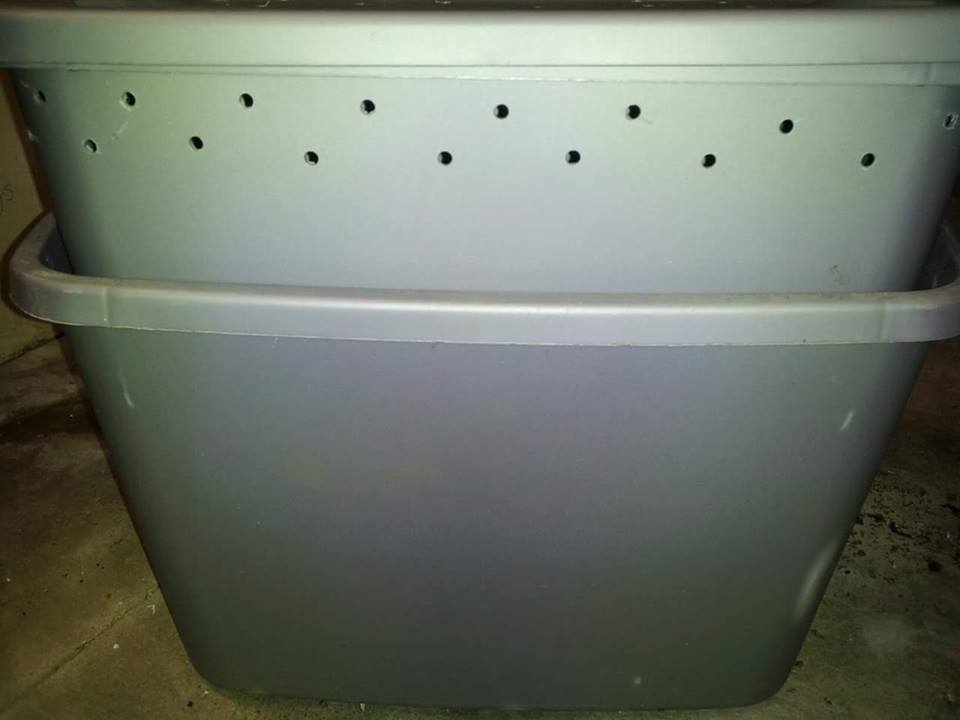
UPPER BIN – Vent Holes
Drill holes in
- upper side
- lid of upper bin


Worm composters are a great place to use shredded paper and food scraps!
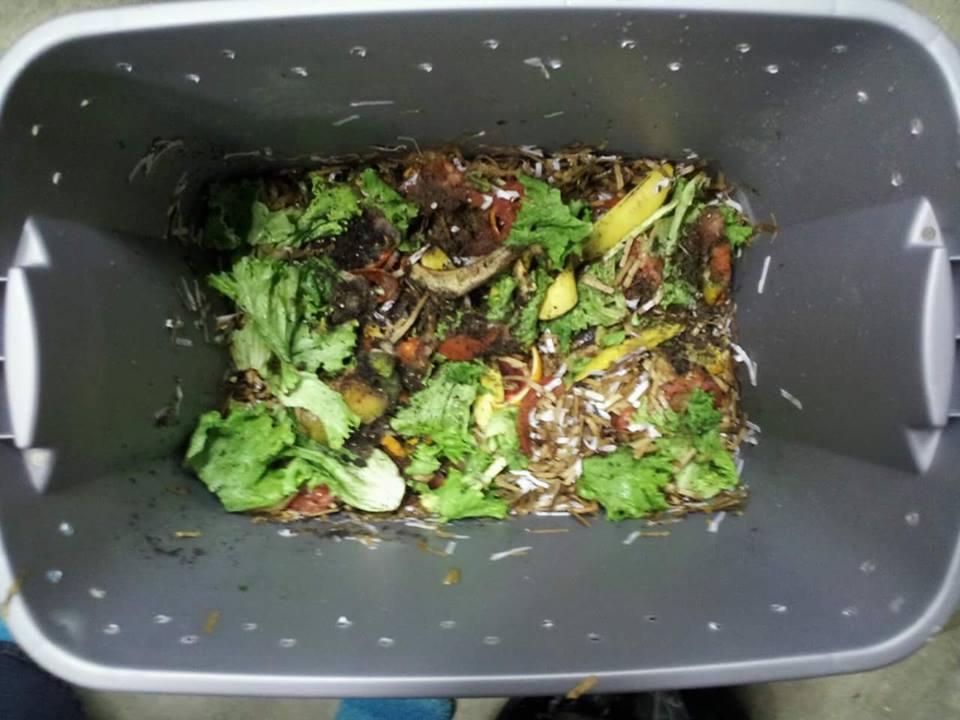
Where to Place Your Worm Factory
Worms do not like it too hot or too cold. I store mine inside the garage. Never leave them outside in harsh winters or extreme hot summers and never in the direct sun.
Rotating Your Worm Bins
I have two bins so that I can harvest and move the worms to a fresh bin and use the finished castings for worm tea.
~Shannon Black
I bought a pound of them and started 1 hut last spring. By fall they had tripled and I split off for 2 more. I over wintered them in my spring house which never gets below 40. They’ve done well.
~Angelia Silvera
Worm farms can be a great hobby that serves your garden and indoor plants as well. Some who start it as a hobby end up selling their worms and turning it into a business.
Find more on ideas on backyard growers and gardening for profit.
Shannon’s process makes it super simple and easy to replicate. However, if you don’t have time to make your own or monitor the health of your worms and feed them regularly, you may prefer either a ready-made worm tower, or even to buy worm castings.
So, we really like how super simple Shannon made hers! Her worms are doing so well she plans to add more!
Thanks to the lovely and industrious Shannon Black for sharing her experience with us all!
More Community Contributions on How to Make a Worm Farm
Sandy McQueen has a different perspective on how she’s cultivating her worm farms and shares thoughts on why not to use stable totes.
8 Pounds of Worms in 5 Worm Farms
By Sandy McQueen
This post is more from a gardeners perspective.
1) You should never get your composting worms from a bait shop….those either need a cool climate or they are bait and not composting worms
2) Stackable totes….outdoors a cheap tote will become brittle and you will have to replace often
3) When stackable totes are full of castings they are heavy and you have to unstack once a week to fluff castings and bedding in order to check on moisture. Unprocessed food leads to sour farm and poor worm health
4) Stackable totes and worm tea can leave a bottom full of unprocessed decomposing liquid (leachate), which is NOT worm tea, and NOT GOOD for use as fertilizer. Worm tea is made from only castings (the lazy way) – by soaking only castings, or the better wa, by soaking castings in water, then aerate for 24 hours with a small amount of molasses.
If you want to do a worm farm correctly….one single stand alone tote is best….you start them at different times and will have a continuous supply of castings when you harvest from each tote.
Purchase a minimum of a pound of Eisenia Fetida (Red Wrigglers) since the worms can only eat their weight in one week…hence 1 lb of worms = 1 lb of food scraps, bedding and organic matter.
You need to control nitrogen, carbon and moisture levels and the worms will multiply in order to handle more food and waste…hence more castings.
A proper worm farm should have little or no extra liquid. Place worm farm in a very shaded area outside (a shed or garage is best). But know that you may have to be able to remedy extreme weather conditions.
I started with 2 lbs and I now have 8 lbs of worms in 5 farms to handle my needs….they all reside in my little unused dining room.
Thanks to Sandy for sharing her approach to worm farming. We love learning the different approaches that work. We do not discount what’s working for others, and like to include multiple perspectives, including down-home wisdom and experience as well as citing scientific and expert research as you will see further below.
Rather than one right way, there’s usually multiple approaches that work.
7 Year Old Worm Colony
By Sarah Murrey, yoga instructor, houseplant fanatic and gardener
My worm colony is 7 years old, and I love them! 🥰
I have them in Rubbermaid composting bins. I have 2 Worm Factory 360 composters but living in Colorado the climate is so dry, I was better off sticking to the Rubbermaid method.
Different Kinds of Worm Bins
- Horse trough
- Lasagna layered garden
- Rubbermaid tubs
- Swimming pool, (small plastic kiddie pool)
- Worm Factory Composter 360
I had them also in a lasagna layered garden, and in a large horse trough with compost and dirt and veggies with a large PVC pipe with holes where I could add new compost into it, but have moved and haven’t reset up.
EDITOR’S NOTE: this PVC core sounds similar to the Plant Tower method.
As long as they have moisture and food, and don’t freeze, they will stay and grow. I turn them a little here and there when they need it (being so mature they are more self sufficient.) Then do a big turn in spring and fall, along with a major feed in fall, then put them in a cool dark place for winter and barely look at them till spring.
Selling Worms Online
I sell worms on the online yard sale. And use their dirt in my 100 house plants and random gardens. Occasionally, I let some go to fisherman. Haha
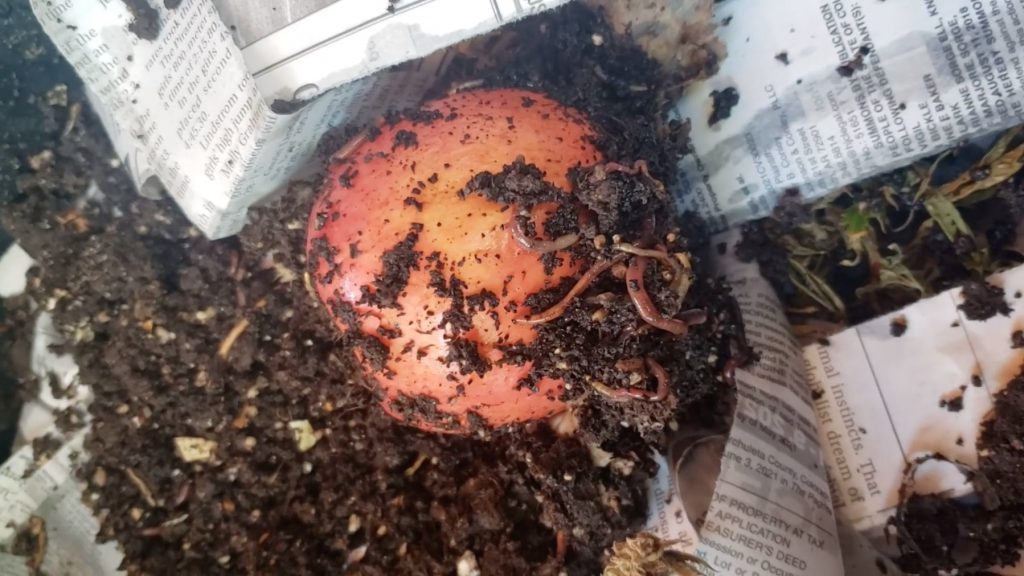
Mature Worms
I should point out this apple is in a very mature bin in summer with thousands of worms! It would be harmful in a newer setup to put in a whole apple. This bin is actually a covered kids swimming pool.
And just like you give chickens shells and stones to aid their digestion, worms need eggshells, coffee grounds or/and other fine things to help digestion as well, like a chicken…but smaller. 😉
These are red wigglers and European earthworms from Jim’s worm farm about 7 years ago. It’s a wonderful place to learn about and get healthy worms.
I love sharing worms and how to’s for them as well! Speaking of which… Get dirt from someone with an established colony when starting to really boost your new set up.
Thanks so much for sharing the worm love!! 💞
To join the Gardens All Facebook conversations where you can post your comments and questions. You can access that specific thread here.[1]https://www.facebook.com/gardensall/posts/841084732662329
Benefits of Worm Castings – Red Wigglers to the Rescue!
A 20 percent concentration of vermicompost mixed in the soil will boost the resistance of host plants against caterpillar and aphid pests.
~Source: NCSU Research project GS09-078[2]https://projects.sare.org/sare_project/GS09-078/
Natural Insect Repellent
Worm castings naturally repel insects due to an enzymes called chitinase. Walking insects such as ants won’t cross the layer and ants in nests under the layer will evacuate nests to get away from the worm castings. Further, pests deterred by worm castings include white flies, aphids and spider mites, cabbage worms and any pest that feeds on plant juices.[3]https://patents.google.com/patent/US20020090669A1/en[4]https://www.southernsare.org/SARE-in-Your-State/North-Carolina/State-News/NCSU-Research-Explains-How-Vermicompost-Amended-Soils-Ward-Off-Crop-Pests[5]https://vermisterra.com/research/vermicompost-wards-off-crop-pests/
Natural Plant Protection
Ongoing studies reveal tremendous benefits and potential in vermicompost, including plant pest control and protection from fungi. According to recent studies, applying earthworm castings to the soil around your plants increases the production of a certain enzyme chitinase.[6]https://news.cornell.edu/stories/2011/12/research-worm-compost-can-suppress-plant-disease[7]https://composting.ces.ncsu.edu/2016/09/earthworm-castings-as-plant-growth-media/
Yes, You Can Buy Castings Tea
We don’t have worms yet, so we looked into getting casting “tea” on Amazon, and you can get it in gallon sized jugs that should last your garden for about 8 weeks if you apply it once per week.
Organic Compost – the Very Best for Your Garden
If you want even more wonderful organic soil you may want to blend your worm castings in with your garden compost of plants, leaves and kitchen scraps.
If you have a mid-to-large sized family, you’ll also end up with more veggies for compost than will fit in your worm farm. For those, you can check out this article on best compost tumblers.
WORM CASTINGS: Feed, Fend and Fight for Your Plants
FEED: Fertilize with nutrients
SOURCE: Cornell University
FEND: Protect plants from pests
FIGHT: Protect plants from disease
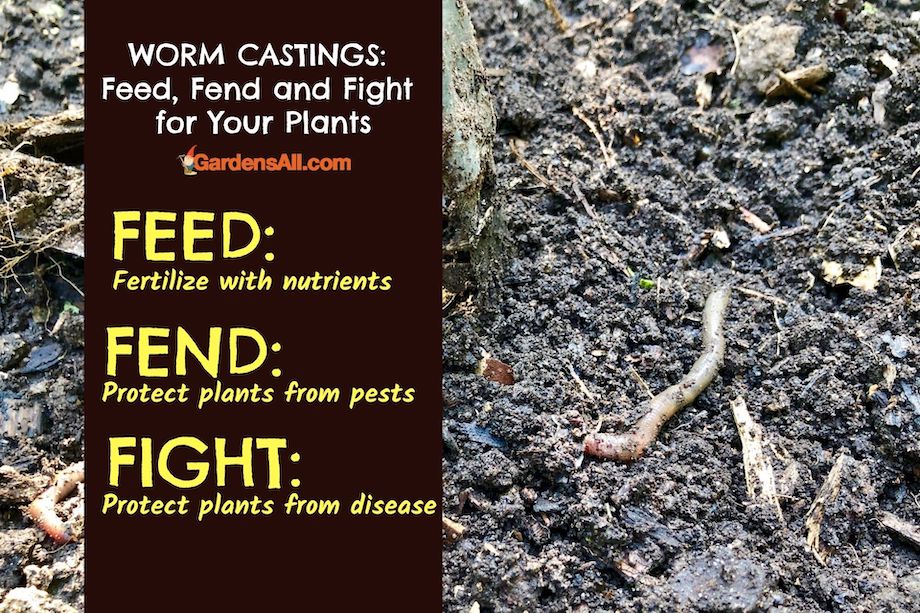
More on How to Make a Worm Farm
For more on worm bins and other tips check out this video with Clint. His tutorial covers a number of good tips he’s learned from direct experience, like Shannon. The best classroom is hands-on!
Vermiculture
Making Organic Garden Soil from Worms and Castings
Vermiculture is growing in popularity for organic gardeners for the rich fertilizer of worm castings. This “black gold” as it’s called, will keep your fruit and veggies thriving in a rich soil conditioner. fertilizer and now natural pesticide it seems!
There’s actually a site named WormPoop.com and well, they have the scoop on (drum roll….) worm poop!..starting off with a succinct definition to sum it all up.
What is VERMICULTURE?
Vermiculture is the process of using worms to decompose organic food waste into a nutrient-rich material to help sustain plant growth.
“This method is simple, effective, convenient, and noiseless. It saves water, energy, landfills, and helps rebuild the soil. The worms’ ability to convert organic waste into nutrient-rich material reduces the need for synthetic fertilizers.”[8]https://www.wormpoop.com/composting/composting.htm
You may also enjoy this article on a friend’s website on how to compost with worms.
How to Keep Compost Worms Warm in Winter
In this helpful 2 minute video by OneYardRevolution (OYR), Patrick covers how they keep their red wiggler worms cozy through the winter in zone 5.
- Choose a sunny location.
- Build a large hot compost pile for the worms in the fall, thats 1 cubic yard or larger)
- Regularly add brown and green composting materials as the compost cooks down
- Cover the pile with a sheet of plastic to add insulation
And… to close with a little garden humor.
Funny Garden Meme
You know you can actually buy worm castings on Amazon?!
GardensAll.com
Wonder why worms rate such an elegant name for worm poo? 🤔
Well I guess it wouldn’t work to say:
“You’re full of castings.” 😉
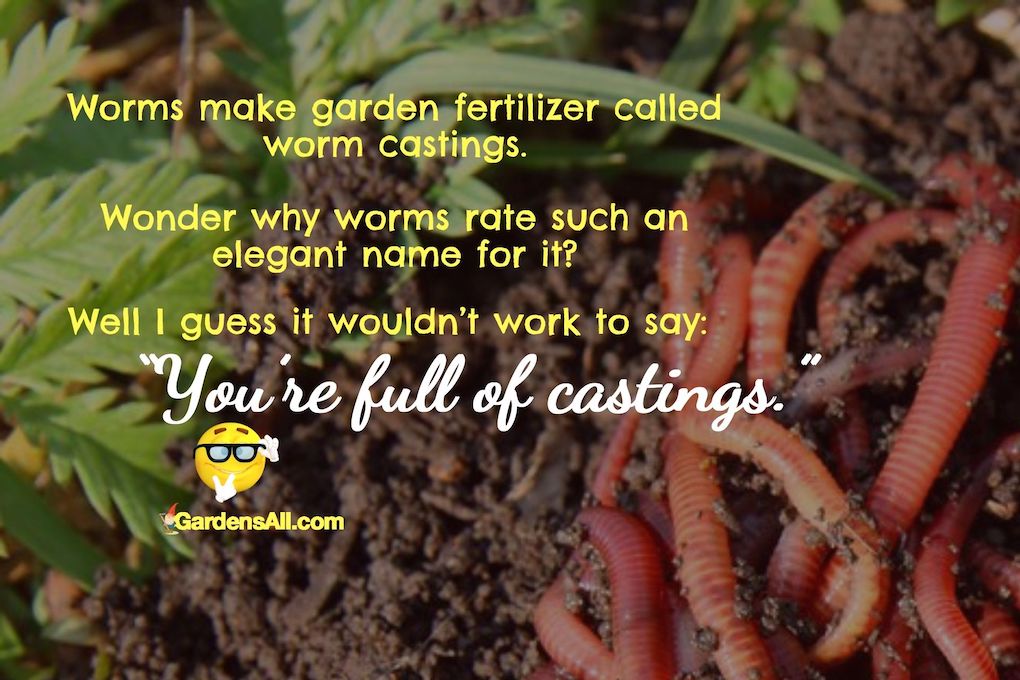
Send us your favorite garden funnies, and we’ll add them to our garden memes and quotes article.
We are an online gardening publication sharing all things garden related! Including urban farming, family gardening, homesteading, gardening for profits, and more. We’re all about growth!
References


